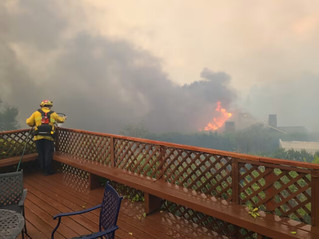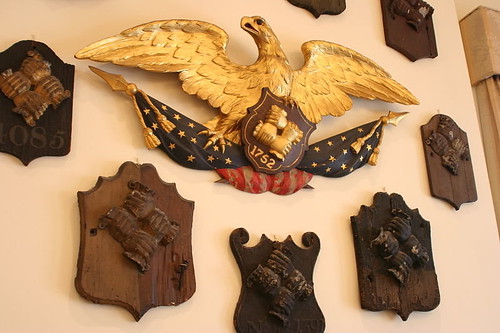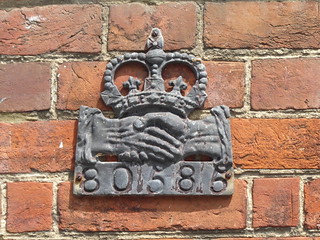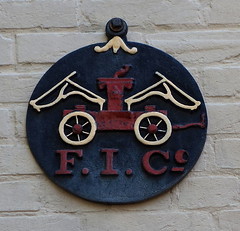
PREV ARTICLE
NEXT ARTICLE
FULL ISSUE
PREV FULL ISSUE
COLLECTING FIRE MARKSIn Pete Smith's article elsewhere in this issue, I noted that, "When you've been immersed in numismatics long enough, you can't help but see numismatic connections everywhere." How about a numismatic connection to the recent California wildfires? -Editor
Johnson didn't simply dial 911 as others in the wildfire's path did: He turned to his private firefighting system for protection. Johnson pays about $5,000 a year to lease the system, a pump-and-hose apparatus that can draw large amounts of water from his swimming pool to help fight the progress of wildfires and backstop the city's municipal firefighters and hydrants. Just as Johnson and his wife started hosing down their property in hopes of preventing any embers from igniting, a man sent by the system's supplier, Fire Defense Service, showed up to help them. The Johnsons soon evacuated, believing they would never see their house again. But the man from Fire Defense stayed behind to help protect their house and a neighbor's who was also a client. "His plan was to fight it if it came," Johnson recalled. As the inferno engulfed parts of the Los Angeles area, tensions have flared over the crews of private firefighters who have been spotted roaming affected neighborhoods and battling the blazes for their clients. A few years earlier, during the 2018 Woolsey fire, Kanye West and Kim Kardashian were criticized after crediting private firefighters for saving their Hidden Hills home (though residents later said the private crews showed up after the fire had gone). The reality is more nuanced. While there are some firefighters-for-rent battling the Los Angeles blazes for the well-heeled, most so-called private firefighters aren't hired by homeowners or business owners, but by insurance companies. As fires have become more frequent and expensive for insurers, some have taken matters into their own hands by paying for private firefighting crews. Insurers, including Chubb and USAA, feature the private-firefighter service in homeowner policies they offer in fire-prone areas across the U.S. The insurer-paid firefighters say they don't favor more expensive properties during a fire, but give priority to client properties that are most at risk, whatever their value. They generally don't directly battle blazes. Instead, their crews try to get to client homes ahead of a fire, sealing off vents to keep embers from getting in, moving combustibles away from the structure, and sometimes spraying fire-retardant gel on the house. As these private crews hopscotch among neighborhoods with client maps in hand, they bypass homes without such coverage.
To read the complete article, see:
I know what you're thinking - the numismatic connection is Johnson's Olympic medals. Actually no - Johnson's house survived the fire - although other Olympians have lost medals to the fire, and may get them replaced. The connection goes back to colonial times in the U.S. Here's an excerpt from an earlier article on Fire Marks, which I first learned about many years ago from my friend Armor Murdoch, an elderly fellow member of the Western Pennsylvania Numismatic Society. -Editor DECORATIVE CRESTS BEARING EAGLES, CLASPED hands, and shining suns were once signs of membership in a special club. They showed that the building to which they were affixed was insured against fire—and that if the building caught on fire, a private fire brigade would come to attempt to put it out. Now, long after their heyday, these plaques, known as "fire marks," have become collector's items—every bit as fascinating and artful today as they were when they were installed. After the Great Fire of London in September 1666, which damaged or destroyed huge swaths of the historic city, the need for a more organized response to fires became tragically apparent. This led to the creation of the world's first property insurance policies, issued by what is considered the world's first insurance company, called the "Fire Office." Despite its official-sounding name, the Fire Office was not a municipal department, but a private company. At the beginning, it provided money for the restoration or reconstruction of buildings damaged by fire. By the time that the idea of fire insurance made its way to the Untied States, volunteer fire brigades were already a well-established tradition to protect the common good. Fire marks, which first took hold in Philadelphia, where some can still be found today, functioned simply as insurance advertisements, and as a sort of turf mark. The most iconic of Philadelphia's fire marks was that of the Ben Franklin–founded Philadelphia Contributionship, which bore the image of four hands grabbing each other by the wrists. It was often molded out of metal and affixed to a wooden shield. Today, fire marks survive as historic points of interest or collector's items. Like philatelists and numismatists (collectors of stamps and coins, respectively), people who study and collect fire marks have a name: signevierists. Probably the most organized group of signevierists is the Fire Mark Circle of America, which oversees a number of auctions and connects enthusiasts. Their auction listings even act as a sort of database of the wide variety of preserved marks being traded around. Are there any signevierists among our readers? -Editor
To read the earlier E-Sylum article, see:
Wayne Homren, Editor The Numismatic Bibliomania Society is a non-profit organization promoting numismatic literature. See our web site at coinbooks.org. To submit items for publication in The E-Sylum, write to the Editor at this address: whomren@gmail.com To subscribe go to: Subscribe All Rights Reserved. NBS Home Page Contact the NBS webmaster 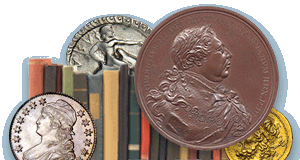
|
